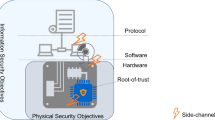Abstract
Ever since the initial idea of quantum computing, the quest for processing data faster never took an offspeed. With the invention of Shor’s and Grover’s algorithm, it has given the boost amongst researchers to develop a successful quantum computer that can outperform any classical system available this day. Due to its working principle and different properties of qubits, many of the tasks which are difficult to perform for current systems can be done efficiently using quantum computers. Revolution in computing will breach existing security approaches and lead us to find alternatives to withstand quantum attacks. Post-quantum cryptography is the most promising way to secure our existing digitized world, as it is not based on discrete logarithms and integer factorization concepts. They are based on other hard mathematical concepts that are hard to break in polynomial time. Therefore, tremendous research has been done in the last decade to design stable, efficient, and secure post-quantum cryptographic approaches. Hash-based, code-based, and lattice-based approaches are well understood, and many of their approaches are standardized for practical implementations.
Access this chapter
Tax calculation will be finalised at checkout
Purchases are for personal use only
Similar content being viewed by others
References
Peter S (2000) Introduction to quantum algorithms. In: AMS proceedings of symposium in applied mathematics, 58. https://doi.org/10.1090/psapm/058/1922896
Elsayed N, Maida AS, Bayoumi M (2019) A review of quantum computer energy efficiency. In: IEEE Green Technologies Conference(GreenTech), Lafayette, LA, USA, 1–3. https://doi.org/10.1109/GreenTech.2019.8767125
Siddhartha Sankar Biswas (2017) Quantum computers: a review work. Adv Comput Sci Technol 10(5):1471–1478
Feynman RP (1982) Simulating physics with computers. Int J Theoretical Phys 467–488. https://doi.org/10.1007/BF02650179
Hidary JD (2019) A brief history of quantum computing. In: Quantum computing: an applied approach. Springer, Cham. https://doi.org/10.1007/978-3-030-23922-0_2
Krantz P, Kjaergaard M, Yan F, Orlando T, Gustavsson S, Oliver W (2019) A quantum engineer's guide to superconducting qubits. Appl Phys Rev 6:021318. https://doi.org/10.1063/1.5089550
Kanamori Y, Yoo S-M, Pan W, Sheldon FT (2006) A short survey on quantum computers. Int J Comput Appl 28. https://doi.org/10.2316/Journal.202.2006.3.202-1700
Cincotti G (2009) Prospects on planar quantum computing. J Lightwave Technol 27(24):5755–5766. https://doi.org/10.1109/JLT.2009.2032371
Menon PS, Ritwik M (2014) A comprehensive but not complicated survey on quantum computing. IERI Proc 10:144–152. ISSN 2212-6678. https://doi.org/10.1016/j.ieri.2014.09.069
Bowden CM, Chen G, Diao Z, Klappenecker A (2002) The universality of the quantum Fourier transform in forming the basis of quantum computing algorithms. J Math Anal Appl 274(1):69–80
Grover LK (1996) A fast quantum mechanical algorithm for database search. In: Proceedings of the twenty-eighth annual ACM symposium on Theory of Computing (STOC '96). Association for Computing Machinery, New York, NY, USA, pp 212–219. https://doi.org/10.1145/237814.237866
Kasivajhula S (2006) Quantum computing: a survey. In: Proceedings of the 44th annual Southeast regional conference (ACM-SE 44). Association for Computing Machinery, New York, NY, USA, pp 249–253
Roffe J (2019) Quantum error correction: an introductory guide. Contemp Phys 60:226–245
The D-Wave 2000Q Quantum Computer Technology Overview (Online). Available: https://www.dwavesys.com/sites/default/files/DWave%202000Q%20Tech%20Collateral0117F.pdf
Shor PW (1999) Polynomial-time algorithms for prime factorization and discrete logarithms on a quantum computer. SIAM Rev 41(2):303–332
Zhang H, Ji Z, Wang H, Wu W (2019) Survey on quantum information security. China Commun 16(10):1–36. https://doi.org/10.23919/JCC.2019.10.001
Buchmann J, Dahmen E, Hulsing A (2011) XMSS—a practical forward secure signature scheme based on minimal security assumptions. In: Yang BY (ed) Post-quantum cryptography, PQCrypto 2011, vol 7071. LNCS. Springer, Berlin, pp 117–129
Suhail S, Hussain R, Khan A, Hong CS (2021) On the role of hash-based signatures in quantum-safe Internet of Things: current solutions and future directions. IEEE Internet Things J 8(1):1–17. https://doi.org/10.1109/JIOT.2020.3013019
Niederhagen R, Waidner M (2017) Practical post-quantum cryptography. SIT-TR-2017-02
Baldi M, Bianchi M, Chiaraluce F et al (2016) Enhanced public key security for the McEliece cryptosystem. J Cryptol 29:1–27. https://doi.org/10.1007/s00145-014-9187-8
Véron P (2013). Code based cryptography and steganography. https://doi.org/10.1007/978-3-642-40663-8_5
Niederhagen R, Waidner M (2017) Practical postquantum cryptography. SIT-TR-2017-02
Bernstein DJ, Hopwood D, Hulsing A, Lange T, Niederhagen R, Papachristodoulou L, Schneider M, Schwabe P, WilcoxO'Hearn Z (2015) SPHINCS: practical stateless hashbased signatures. In: Fischlin M, Oswald E (ed) Advances in cryptology, EUROCRYPT 2015, vol 9056. LNCS. Springer, Berlin, pp 368–397
Repka M, Zajac P (2014) Overview of the mceliece cryptosystem and its security. Tatra Mountains Mathematical Publications. 60. https://doi.org/10.2478/tmmp-2014-0025
Hoffstein J, Howgrave-Graham N, Pipher J, Whyte W (2009) Practical lattice-based cryptography: NTRUEncrypt and NTRUSign. In: Nguyen P, Vallée B (eds) The LLL algorithm. Information Security and Cryptography. Springer, Berlin. https://doi.org/10.1007/978-3-642-02295-1_11
Güneysu T, Lyubashevsky V, Pöppelmann T (2012) Practical Lattice-based cryptography: a signature scheme for embedded systems. In: Prouff E, Schaumont P (eds) Cryptographic hardware and embedded systems—CHES 2012. CHES 2012. Lecture Notes in Computer Science, vol 7428. Springer, Berlin. https://doi.org/10.1007/978-3-642-33027-8_31
Petzoldt A, Chen M-S, Yang B-Y, Tao C, Ding J (2015) Design principles for HFEv-based multivariate signature schemes. In: Iwata T, Cheon JH (eds) Advances in cryptology—ASIACRYPT 2015, vol 9452. LNCS. Springer, Berlin, pp 311–334
Costello C, Longa P, Naehrig M (2016) Efficient algorithms for supersingular ısogeny Diffie-Hellman. In: Robshaw M, Katz J (eds) Advances in cryptology—CRYPTO 2016, vol 9814. LNCS. Springer, Berlin, pp 572–601
Author information
Authors and Affiliations
Corresponding author
Editor information
Editors and Affiliations
Rights and permissions
Copyright information
© 2022 The Author(s), under exclusive license to Springer Nature Singapore Pte Ltd.
About this paper
Cite this paper
Tandel, P.H., Nasrıwala, J.V. (2022). Post-Quantum Cryptography: A Solution to Quantum Computing on Security Approaches. In: Ranganathan, G., Bestak, R., Palanisamy, R., Rocha, Á. (eds) Pervasive Computing and Social Networking. Lecture Notes in Networks and Systems, vol 317. Springer, Singapore. https://doi.org/10.1007/978-981-16-5640-8_46
Download citation
DOI: https://doi.org/10.1007/978-981-16-5640-8_46
Published:
Publisher Name: Springer, Singapore
Print ISBN: 978-981-16-5639-2
Online ISBN: 978-981-16-5640-8
eBook Packages: Intelligent Technologies and RoboticsIntelligent Technologies and Robotics (R0)




